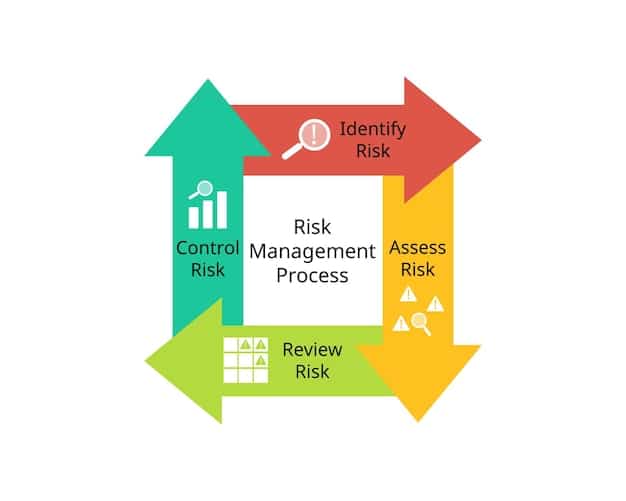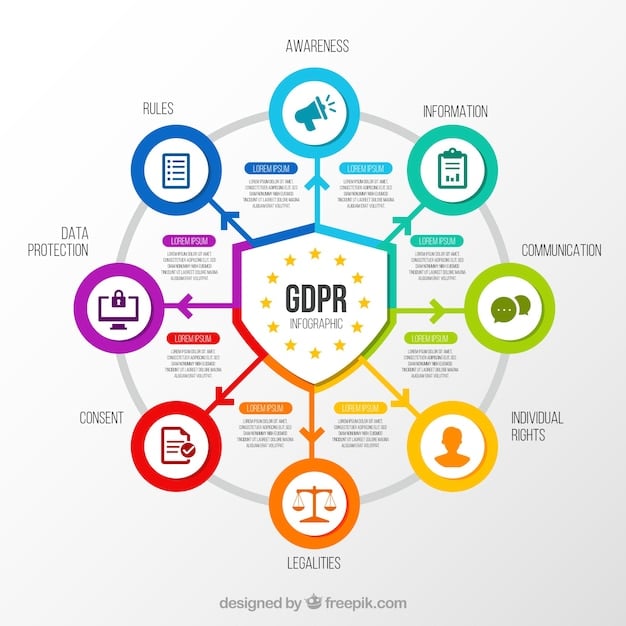PCI DSS Compliance for E-commerce: Avoid 2025 Fines & Breaches

Ensuring your e-commerce store is PCI DSS compliant is crucial for avoiding hefty fines and data breaches in 2025; this involves implementing robust security measures, adhering to specific requirements, and undergoing regular audits to protect customer payment data.
Is your e-commerce store prepared for 2025? The stakes are high when it comes to safeguarding customer payment information. Achieving and maintaining PCI DSS compliance is not just a regulatory requirement; it’s vital for protecting your business and your customers from costly data breaches and significant fines.
Understanding PCI DSS: The Basics
The Payment Card Industry Data Security Standard (PCI DSS) is a set of security standards designed to protect cardholder data. It applies to all entities that store, process, or transmit cardholder data, including e-commerce stores. Understanding the basics is the first step toward ensuring your business is compliant.
What is PCI DSS?
PCI DSS was created by major credit card companies like Visa, Mastercard, American Express, Discover, and JCB to minimize credit card fraud. By adhering to these standards, businesses reduce the risk of data breaches and maintain customer trust.
PCI DSS compliance isn’t a one-time event; it’s an ongoing process. It requires businesses to regularly assess their systems, implement security controls, and maintain documented procedures. Neglecting compliance can lead to severe consequences, including fines, legal action, and reputational damage.
Who Needs to Comply?
Any business that accepts, processes, stores, or transmits credit card information must comply with PCI DSS. This includes e-commerce stores, brick-and-mortar retailers, and service providers. The specific requirements vary depending on the transaction volume and how cardholder data is handled.
- Small businesses processing a low volume of transactions may be subject to simpler validation requirements.
- Large enterprises handling millions of transactions will need to undergo rigorous audits and implement advanced security measures.
- Service providers that handle cardholder data on behalf of other businesses have separate, more stringent requirements.
Knowing your specific compliance level is critical. Contact your payment processor or acquiring bank to determine the requirements that apply to your business.

In summary, PCI DSS is a vital framework for protecting cardholder data. Understanding its requirements and determining your compliance level is essential for safeguarding your e-commerce store from security threats and financial penalties.
Key Requirements of PCI DSS for E-commerce
PCI DSS outlines 12 key requirements that businesses must implement to protect cardholder data. These requirements are grouped into six control objectives. Let’s explore these requirements and how they apply to e-commerce stores.
Build and Maintain a Secure Network
This objective focuses on establishing a secure infrastructure to protect cardholder data from unauthorized access. It includes:
- Installing and maintaining a firewall configuration to protect cardholder data.
- Changing vendor-supplied defaults for system passwords and other security parameters.
Firewalls act as barriers between your network and the internet, blocking unauthorized traffic. Strong passwords and secure configurations prevent attackers from exploiting vulnerabilities.
Protect Cardholder Data
This objective emphasizes safeguarding cardholder data both when it’s stored and transmitted. It includes:
- Protecting stored cardholder data.
- Encrypting transmission of cardholder data across open, public networks.
Encryption is a crucial tool for protecting sensitive data. Use strong encryption algorithms and secure protocols like Transport Layer Security (TLS) to protect cardholder data during transmission.
Maintain a Vulnerability Management Program
This objective involves regularly scanning for vulnerabilities and patching systems to prevent exploitation. It includes:
- Using and regularly updating anti-virus software.
- Developing and maintaining secure systems and applications.
Regularly scan your systems for vulnerabilities and promptly apply security patches. Keep your anti-virus software up-to-date to detect and prevent malware infections. Security patches fix known vulnerabilities and prevent attackers from exploiting them.
Implement Strong Access Control Measures
This objective focuses on restricting access to cardholder data to authorized personnel only. It includes:
- Restricting access to cardholder data on a need-to-know basis.
- Assigning a unique ID to each person with computer access.
- Restricting physical access to cardholder data.
Implement strong access control policies and procedures. Use multi-factor authentication to enhance security and prevent unauthorized access. Limit physical access to areas where cardholder data is stored or processed.
Regularly Monitor and Test Networks
This objective involves continuously monitoring your network for security breaches and testing security controls. It includes:
- Tracking and monitoring all access to network resources and cardholder data.
- Regularly testing security systems and processes.
Implement intrusion detection systems (IDS) and security information and event management (SIEM) tools to monitor your network for suspicious activity. Conduct regular penetration testing to identify vulnerabilities and assess the effectiveness of your security controls.
Maintain an Information Security Policy
This objective emphasizes establishing and maintaining a comprehensive information security policy. It includes:
- Maintaining a policy that addresses information security for all personnel.
Develop a comprehensive information security policy that outlines your organization’s commitment to protecting cardholder data. Train your employees on security policies and procedures. Regularly review and update your security policies to address evolving threats and changes in your business environment.

Adhering to these key requirements is crucial for maintaining PCI DSS compliance and protecting your e-commerce store from data breaches. Understanding and implementing these measures will help you safeguard customer payment data and maintain their trust.
Steps to Achieve PCI DSS Compliance
Achieving PCI DSS compliance can seem daunting, but breaking it down into manageable steps can make the process more straightforward. Here’s a practical guide to help your e-commerce store achieve and maintain compliance.
Assess Your Current Environment
The first step is to assess your current environment to identify where cardholder data is stored, processed, or transmitted. This includes reviewing your network infrastructure, systems, and applications.
- Conduct a thorough risk assessment to identify potential vulnerabilities and threats.
- Document your cardholder data flow to understand how data enters, moves through, and exits your systems.
- Determine your PCI DSS compliance level based on your transaction volume and risk profile.
A clear understanding of your current environment is essential for developing an effective compliance strategy.
Implement Security Controls
Based on your assessment, implement the necessary security controls to meet PCI DSS requirements. This may involve upgrading your systems, implementing new technologies, or modifying existing processes.
- Install and configure firewalls to protect your network perimeter.
- Encrypt cardholder data both at rest and in transit.
- Implement strong access control measures to restrict access to sensitive data.
Ensure that all security controls are properly configured and maintained. Regularly review and update your security controls to address evolving threats.
Document Policies and Procedures
Documenting your security policies and procedures is a crucial step in achieving PCI DSS compliance. This documentation should clearly outline how you protect cardholder data and comply with PCI DSS requirements.
- Develop a comprehensive information security policy that addresses all PCI DSS requirements.
- Create detailed procedures for handling cardholder data, incident response, and vulnerability management.
- Ensure that all employees are trained on security policies and procedures.
Documented policies and procedures demonstrate your commitment to security and provide a framework for maintaining compliance.
Undergo a Compliance Assessment
Once you have implemented the necessary security controls and documented your policies and procedures, you will need to undergo a compliance assessment. The type of assessment depends on your PCI DSS compliance level.
- Level 1 merchants must undergo an annual on-site audit by a Qualified Security Assessor (QSA).
- Level 2-4 merchants may be able to complete a Self-Assessment Questionnaire (SAQ).
- Regardless of your level, you will need to submit a Attestation of Compliance (AOC) to your acquiring bank.
The assessment will verify that you have implemented the necessary security controls and are compliant with PCI DSS requirements. If you are using a SAQ, choose the correct one based on your environment. The PCI Security Standards Council website has documentation to help ensure that you select the appropriate SAQ.
Maintain Ongoing Compliance
PCI DSS compliance isn’t a one-time event; it’s an ongoing process. You must continuously monitor your systems, test your security controls, and update your policies and procedures to maintain compliance.
- Conduct regular vulnerability scans and penetration tests.
- Monitor your network for security breaches and suspicious activity.
- Review and update your security policies and procedures at least annually.
By maintaining ongoing compliance, you can protect your e-commerce store from data breaches and avoid costly fines.
By following these steps, you can achieve and maintain PCI DSS compliance, protecting your e-commerce store and your customers from security threats.
The Cost of Non-Compliance
Failing to comply with PCI DSS can have severe financial and reputational consequences for your e-commerce store. Understanding the potential costs of non-compliance is crucial for prioritizing security and maintaining compliance.
Fines and Penalties
The most immediate cost of non-compliance is the potential for fines and penalties. These fines can be substantial, ranging from $5,000 to $100,000 per month, depending on the severity of the violation and the size of the business.
Fines are typically imposed by the payment card brands (Visa, Mastercard, etc.) and are passed on to the merchant by their acquiring bank. The fines are intended to cover the costs associated with investigating and remediating data breaches and fraud.
Data Breach Costs
A data breach can be incredibly expensive, involving direct and indirect costs. Direct costs include:
- Forensic investigations to determine the cause and scope of the breach.
- Notification costs to inform affected customers about the breach.
- Credit monitoring services to protect customers from identity theft.
- Legal fees and litigation costs.
- Fines and penalties from regulatory authorities.
Indirect costs can be even more significant and include:
- Loss of customer trust and damage to reputation.
- Decreased sales and revenue.
- Increased insurance premiums.
The average cost of a data breach for small businesses can range from $36,000 to $50,000, according to the National Cyber Security Alliance . For larger enterprises, the costs can reach millions of dollars.
Legal and Regulatory Consequences
Non-compliance with PCI DSS can also lead to legal and regulatory consequences. Depending on the nature and severity of the violation, businesses may face lawsuits, regulatory investigations, and enforcement actions.
In some cases, executives and board members may be held personally liable for data breaches and security violations. Regulatory bodies like the Federal Trade Commission (FTC) have the authority to investigate and prosecute businesses for unfair or deceptive practices related to data security.
Loss of Business
Perhaps the most devastating consequence of non-compliance is the potential loss of business. A data breach can erode customer trust and confidence, leading to decreased sales and revenue.
- Customers may switch to competitors who have a reputation for strong data security.
- Partners and suppliers may terminate contracts due to concerns about security risks.
- The business may be unable to process credit card transactions, effectively shutting down its e-commerce operations.
In some cases, a data breach can be so severe that it leads to the closure of the business.
The costs of non-compliance with PCI DSS are substantial and far-reaching. By prioritizing security and maintaining compliance, you can protect your e-commerce store from financial losses, reputational damage, and legal consequences.
Staying Updated with PCI DSS Changes
The PCI DSS is not static; it evolves to address emerging threats and changes in the payment card industry. Staying updated with the latest changes is crucial for maintaining ongoing compliance and protecting your e-commerce store.
Regularly Review PCI Security Standards Council Updates
The PCI Security Standards Council (SSC) is responsible for developing and maintaining the PCI DSS. They regularly release updates, guidance, and educational materials to help businesses understand and implement the standards.
- Visit the PCI SSC website to stay informed about the latest changes.
- Subscribe to the PCI SSC newsletter to receive updates directly in your inbox.
- Attend PCI SSC webinars and training sessions to learn about new requirements and best practices.
Monitor Industry News and Trends
In addition to the PCI SSC, stay informed about industry news and trends related to data security and payment processing. This can help you anticipate upcoming changes and prepare your e-commerce store accordingly.
Read industry publications, follow security experts on social media, and participate in industry events to stay up-to-date on the latest developments.
Work with a Qualified Security Assessor (QSA)
A Qualified Security Assessor (QSA) is a cybersecurity expert who is certified by the PCI SSC to conduct PCI DSS assessments. Working with a QSA can provide valuable insights and guidance on how to stay compliant with the latest requirements.
- QSAs have in-depth knowledge of the PCI DSS and can help you identify vulnerabilities and implement effective security controls.
- They can also help you navigate the compliance process and prepare for your annual assessment.
Employee Training and Awareness
Ensure that your employees are trained on the latest security policies and procedures. Provide regular security awareness training to help them identify and avoid phishing attacks, malware infections, and other security threats.
Security awareness training should cover topics such as:
- Password security.
- Phishing awareness.
- Malware prevention.
- Data handling procedures.
- Incident response.
By keeping your employees informed and engaged in security, you can create a culture of security throughout your organization.
Regular Security Audits
Conduct regular security audits to assess the effectiveness of your security controls and identify any gaps in your compliance program. Security audits should cover all aspects of your e-commerce environment, including:
- Network security.
- Application security.
- Data storage and handling.
- Access control.
- Incident response.
Security audits can help you identify vulnerabilities and ensure that your security controls are functioning as intended.
Staying updated with PCI DSS changes requires a proactive and ongoing effort. By following these steps, you can ensure that your e-commerce store remains compliant and protected from security threats.
Preparing for PCI DSS 4.0 in 2025
The PCI Security Standards Council has introduced PCI DSS version 4.0, a significant update to the standard. While the current version 3.2.1 is still valid, understanding and preparing for version 4.0 is crucial, especially as it will become mandatory in 2025.
Key Changes in PCI DSS 4.0
PCI DSS 4.0 introduces several key changes designed to address emerging threats and improve data security. Some of the notable changes include:
- Increased Flexibility: 4.0 offers more flexibility, allowing organizations to customize their security controls to meet specific business needs.
- Enhanced Authentication: Stronger emphasis on multi-factor authentication (MFA) to protect against unauthorized access, making MFA a requirement in more scenarios.
- Targeted Risk Analysis: A more detailed approach to risk assessment, including specific requirements for identifying and mitigating threats.
- Improved Validation Methods: Enhanced validation methods to ensure security controls are effective and consistently implemented.
These changes aim to make the standard more adaptive and resilient to evolving cyber threats.
Steps to Prepare for PCI DSS 4.0
Preparing for PCI DSS 4.0 involves a systematic approach to assess, plan, and implement the necessary changes. Here are some key steps to get started:
- Review the New Standard: Thoroughly review the PCI DSS 4.0 documentation to understand the new requirements and how they differ from version 3.2.1.
- Conduct a Gap Analysis: Perform a gap analysis to identify areas where your current security controls do not meet the new requirements.
- Develop a Remediation Plan: Create a detailed remediation plan to address the gaps identified in the analysis. This plan should include specific actions, timelines, and responsible parties.
- Implement New Controls: Implement the necessary security controls based on your remediation plan. This may involve upgrading systems, implementing new technologies, or modifying existing processes.
- Train Employees: Ensure that your employees are trained on the new security policies and procedures. Provide regular security awareness training to keep them informed about the latest threats and best practices.
- Update Documentation: Update your security policies and procedures to reflect the changes in PCI DSS 4.0. Ensure that all documentation is accurate and up-to-date.
- Test and Validate: Test and validate your security controls to ensure that they are functioning as intended. Conduct regular vulnerability scans and penetration tests to identify and address any vulnerabilities.
Resources for PCI DSS 4.0 Preparation
Several resources are available to help you prepare for PCI DSS 4.0, including:
- PCI Security Standards Council (SSC): The PCI SSC website provides detailed documentation, guidance, and educational materials on PCI DSS 4.0.
- Qualified Security Assessors (QSAs): QSAs can provide expert guidance and support throughout the preparation process. They can help you assess your environment, develop a remediation plan, and validate your security controls.
- Industry Events and Webinars: Attend industry events and webinars to learn from experts and network with other professionals who are preparing for PCI DSS 4.0.
By starting your preparation now, you can ensure a smooth transition to PCI DSS 4.0 and protect your e-commerce store from security threats.
| Key Point | Brief Description |
|---|---|
| 🔒 PCI DSS Compliance | Adhering to security standards to protect cardholder data. |
| ⚠️ Cost of Non-Compliance | Fines can be substantial, ranging from $5,000 to $100,000 per month. |
| 🔄 PCI DSS 4.0 | Becoming mandatory in 2025, featuring increased flexibility and enhanced authentication. |
| 🛡️ Security Measures | Implementing firewalls, encrypting data, and monitoring networks for breaches. |
Frequently Asked Questions (FAQ)
▼
PCI DSS stands for Payment Card Industry Data Security Standard. It’s a set of security standards designed to protect cardholder data, ensuring secure processing, storage, and transmission of credit card information. Compliance is crucial to prevent data breaches and maintain customer trust.
▼
Any organization that handles credit card information, including e-commerce businesses, merchants, and service providers, must comply. The specific requirements vary depending on the business’s transaction volume and processing methods.
▼
Penalties can include substantial fines, ranging from $5,000 to $100,000 per month. Additional consequences may include legal actions, loss of merchant privileges, and damage to your business’s reputation.
▼
Regularly update security systems, conduct vulnerability scans, monitor network activity, and train employees on security protocols. Work with a Qualified Security Assessor (QSA) for guidance and validation.
▼
PCI DSS 4.0 is the latest version of the standard, featuring enhanced security measures. It offers more flexibility for businesses to customize their approach. It becomes mandatory in 2025, so businesses should start preparing now.
Conclusion
In conclusion, ensuring your e-commerce store is PCI DSS compliant is an ongoing, critical process. By understanding the requirements, taking proactive steps to implement security measures, and staying updated with the latest standards, you can protect your business and customers from the risks of data breaches and financial penalties. Take action now to secure your e-commerce future.





